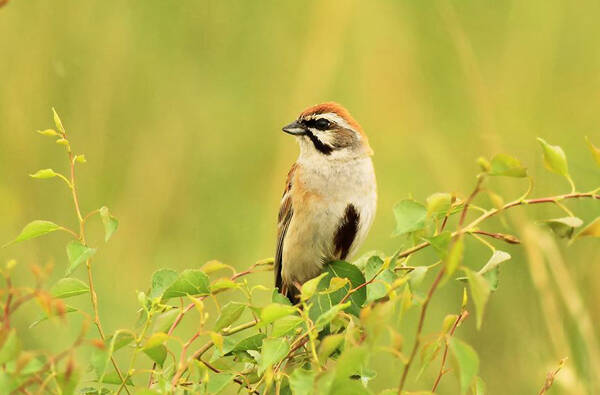Emberiza jankowskii
IUCN
LCBasic Information
Scientific classification
- name:Emberiza jankowskii
- Scientific Name:Emberiza jankowskii,Jankowski's Bunting,Rufous-backed Bunting,Red-bellied Sparrow
- Outline:Songbird
- Family:Passeriformes Pipitidae
Vital signs
- length:14-17cm
- Weight:19-25g
- lifetime:No verification information
Feature
The lower body is dirty white or grayish white, with a distinct heart-shaped chestnut spot in the center of the abdomen
Distribution and Habitat
Distributed in China, the Democratic People's Republic of Korea, and the Russian Federation (East Asia).
It breeds in the southern end of the eastern foothills of the Greater Khingan Range at the junction of Jilin and Inner Mongolia, China, in the areas of Delonggang and Beidagang, and is a resident bird. It is mainly distributed in the vast areas between Heiding Mountain, Yematu, Longquan, Jubao, Dazhuangzi, Lime Kiln, Yongmao Iron Mine and Neishu Tuyouze Tuquan in Jilin, and in Angdai Mountain, Najin, Meiyao, Dongsheng, Zhenxi, and Lingxia. In addition, Bianzhao and Chanyu in Tongyu, Yaotuozi in Changling County, Yueliangpao and Shuangliao County in Da'an County. Erdaopaozi, Sidaopaozi and Yangguanping in Hunchun County in the east of Jilin Province, and Erdao and Songjiang in Antu County. During migration, it is seen in Dongning, Aihe, Jingbo Lake, Acheng, Maoer Mountain, Harbin, Duiqingshan, Beidaihe in the northeast, Linxi in Inner Mongolia and parts of Liaoning Provi
Appearance
Male (summer plumage): forehead, top of head, back, waist and tail upper coverts are generally light brown chestnut, upper back feathers have inconspicuous brown feather shafts; tail feathers are black brown, and the base of the feathers is brown-yellow. The central pair of tail feathers is dirty brown, and the feather shaft is brown; the inner vanes of the two outermost pairs of tail feathers have large white wedge-shaped spots; the small coverts are light gray, the large and middle coverts are light black brown, and the outer vanes are brown-yellow; the flight feathers are dark brown with light brown feather edges; the eyebrow and cheeks are dirty white; the front of the eyes and the zygomatic stripes are dark chestnut; the chin, throat and chest are grayish white; the abdomen is light brown with a clear heart-shaped chestnut spot in the center; the side and undertail coverts are light brown-yellow, and the underwing coverts are dirty white.
Male (winter plumage): There are incons
Details
The foreign name of the Chestnut-bellied Bunting is Jankowski's Bunting, a small songbird with no subspecies.

Most chestnut-bellied buntings wander around in winter, reaching as far as Harbin in China in the north and occasionally as far as Shenyang and Beidaihe in the south. Only a few stay in the breeding area. This bird spends most of its time on the ground, and sometimes among small trees. It mostly lives alone or in pairs, and rarely gathers in large flocks. It is not timid in nature and will hide in bushes or grass when people approach it. Especially when the female bird is incubating eggs, it will not move even when it is close to one meter away.
The main food of the chestnut bunting is weed seeds on the grassland and plant seeds on the wasteland. In summer, there are lepidopteran insects and small coleopteran insects, etc., and these are used to feed the chicks.
Chestnut-bellied buntings start pairing in late April and early May in western Jilin Province, China. At this time, the male birds sing fiercely, and sometimes both males and females chase each other. The nests are mostly built in thin grass on the ground, and a few are built on small shrubs. Trees and nests are mostly built on dwarf trees of Cork Ulmus, and the nests are not very sheltered and easy to find. The nest is shallow bowl-shaped, and the nest materials are composed of grass stems and leaves, thin tall stems, plant top roots, animal hair, horsetail, etc. of Great Miscanthus and Baikal feather thatch. Each clutch lays 5-6 eggs. The background color of the egg is lotus white or light cyan, with many inconspicuous dots or spots of light rose color on it, forming a single piece when viewed from a distance, making the whole egg appear rose color; and there are obvious silky or grass-leaf-like chestnuts scattered around. Brown stripes are mostly concentrated on the blunt end of the egg, but no end ring is formed. One clutch is laid annually, and only the female incubates the eggs.
The total number of Chestnut-bellied Buntings may be less than 500 pairs, assuming unknown populations exist elsewhere, but may be less than 200 pairs (2008). It was placed in a population of 250-999 mature individuals, equivalent to a total of 375-1,499 individuals, rounded here to 350-1,500 individuals. Population sizes are estimated to be 1-10,000 breeding pairs nationwide and 50-1,000 migratory birds, and 50-1,000 wintering birds in China, with an average of 100 breeding pairs and an average of 50 migratory birds in North Korea (2009 ). Trend argument: Although a series of accurate population surveys are lacking, reports of very rapid declines in many locations where the species was previously abundant indicate declines of 50-79% over 11 years (three generations) (2008).
The Chestnut-bellied Bunting is a world-wide endangered bird that is only found south of Vladivostok in the Russian Far East and in northeastern China. The distribution area is narrow and the population is sparse. Due to environmental changes, it has become an isolated island distribution, and the population is decreasing.
Included in the "List of Terrestrial Wild Animals Protected by the State that Are Beneficial or of Important Economic and Scientific Research Value" issued by the State Forestry Administration of China on August 1, 2000 (Item 693).
Listed in the "World Conservation Union Red List of Threatened Species" (IUCN) 2018 ver 3.1 - Endangered (EN).
It is listed in the first level of China's "List of National Key Protected Wild Animals" (February 5, 2021).
Protect wild animals and eliminate wild game.
Maintaining ecological balance is everyone’s responsibility!








